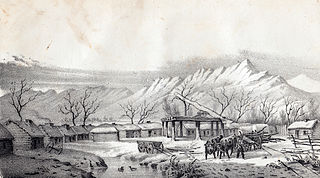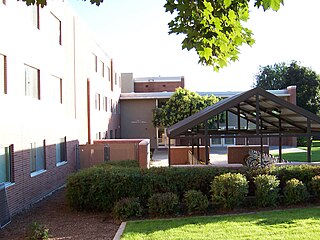
Parowan is a city in and the county seat of Iron County, Utah, United States. The population was 2,790 at the 2010 census, and in 2018 the estimated population was 3,100.

The Mountain Meadows Massacre was a series of attacks during the Utah War that resulted in the mass murder of at least 120 members of the Baker–Fancher wagon train. The massacre occurred in the southern Utah Territory at Mountain Meadows, and was perpetrated by settlers from the Church of Jesus Christ of Latter-day Saints involved with the Utah Territorial Militia who recruited and were aided by some Southern Paiute Native Americans. The wagon train, made up mostly of immigrant families from Arkansas, was bound for California, traveling on the Old Spanish Trail that passed through the Territory.

Fort Bridger was originally a 19th-century fur trading outpost established in 1842, on Blacks Fork of the Green River, in what is now Uinta County, Wyoming, United States. It became a vital resupply point for wagon trains on the Oregon, California, and Mormon Trails. The US Army established a military post here in 1858 during the Utah War, until it was finally closed in 1890. A small town, Fort Bridger, Wyoming, remains near the fort and takes its name from it.

The Mormon Trail is the 1,300-mile (2,100 km) route from Illinois to Utah on which Mormon pioneers traveled from 1846 to 1869. Today, the Mormon Trail is a part of the United States National Trails System, known as the Mormon Pioneer National Historic Trail.

This Is the Place Heritage Park is a Utah State Park that is located on the east side of Salt Lake City, Utah, United States, at the foot of the Wasatch Range and near the mouth of Emigration Canyon. A non-profit foundation manages the park.
Cove Fort is a fort, unincorporated community, and historical site located in Millard County, Utah. It was founded in 1867 by Ira Hinckley at the request of Brigham Young. One of its distinctive features is the use of volcanic rock in the construction of the walls, rather than the wood used in many mid-19th-century western forts. This difference in construction is the reason it is one of very few forts of this period still surviving.

Charles Ora Card was the American founder of Cardston, Alberta, the first Mormon settlement in Canada. He has been referred to as "Canada's Brigham Young". Card was a Mormon pioneer as a teenager, traveling from the eastern United States to Utah Territory in the 1850s. After arriving in Utah, he supervised the construction of the Logan Utah Temple, served as a city councilman, and was appointed to the first board of trustees of Brigham Young College. Card was then tasked by leaders in the Church of Jesus Christ of Latter-day Saints to travel north to Canada and establish a Latter-day Saint colony there. He worked to make the community self-sufficient, participating in irrigation projects. Card was a practitioner of plural marriage, marrying a total of four wives and having sixteen children. He served in leadership positions within the LDS Church, mainly as stake president. He was the spiritual and economic leader of Cardston.

The History of Utah is an examination of the human history and social activity within the state of Utah located in the western United States.

The Baker–Fancher party was a group of American western emigrants from Marion, Crawford, Carroll, and Johnson counties in Arkansas, who departed Carroll County in April 1857 and "were attacked by the Mormons near the rim of the Great Basin, and about fifty miles from Cedar City, in Utah Territory, and that all of the emigrants, with the exception of 17 children, were then and there massacred and murdered" in the Mountain Meadows massacre. Sources estimate that between 120 and 140 men, women and children were killed on September 11, 1857, at Mountain Meadows, a rest stop on the Old Spanish Trail, in the Utah Territory. Some children of up to six years old were taken in by the Mormon families in Southern Utah, presumably because they had been judged to be too young to tell others about the massacre.

Fort Utah was the original European American settlement at modern-day Provo, Utah, United States. The settlement was established March 12, 1849 by President John S. Higbee with approximately 150 persons sent from Salt Lake City to Provo by President Brigham Young.

Ira Nathaniel Hinckley was an early Latter Day Saint leader who supervised the construction and maintenance of Cove Fort, along with his brother Arza Hinckley, a strategically placed fortification about halfway between Salt Lake City and St. George, Utah. He was the father of author Bryant S. Hinckley and LDS apostle Alonzo A. Hinckley, the grandfather of LDS church president Gordon B. Hinckley, and an acquaintance of Joseph Smith Jr.

The Utah Territory during the American Civil War was far from the main operational theaters of war, but still played a role in the disposition of the United States Army, drawing manpower away from the volunteer forces and providing its share of administrative headaches for the Lincoln Administration. Although no battles were fought in the territory, the withdrawal of Union forces at the beginning of the war allowed the Native American tribes to start raiding the trails passing through Utah. As a result, units from California and Utah were assigned to protect against these raids. Mineral deposits found in Utah by California soldiers encouraged the immigration of non-Mormon settlers into Utah.
In 1857, at the time of the Mountain Meadows Massacre, Brigham Young, was serving as President of the Church of Jesus Christ of Latter-day Saints and as Governor of Utah Territory. He was replaced as governor the following year by Alfred Cumming. Evidence as to whether or not Young ordered the attack on the migrant column is conflicted. Historians still debate the autonomy and precise roles of local Cedar City LDS Church officials in ordering the massacre and Young's concealing of evidence in its aftermath. Young's use of inflammatory and violent language in response to a federal expedition to the territory added to the tense atmosphere at the time of the attack. After the massacre, Young stated in public forums that God had taken vengeance on the Baker–Fancher party. It is unclear whether Young held this view because of a possible belief that this specific group posed a threat to colonists or that they were responsible for past crimes against Mormons. According to historian William P. MacKinnon, "After the war, Buchanan implied that face-to-face communications with Brigham Young might have averted the Utah War, and Young argued that a north–south telegraph line in Utah could have prevented the Mountain Meadows Massacre."

The Church of Jesus Christ of Latter-day Saints in Utah refers to the Church of Jesus Christ of Latter-day Saints and its members in Utah. Utah has more church members than any other U.S. state or country. The LDS Church is also the largest denomination in Utah.

The Church of Jesus Christ of Latter-day Saints in Wyoming refers to the Church of Jesus Christ of Latter-day Saints and its members in Wyoming. The church's first congregation in Wyoming was organized in 1877. It has since grown to 67,797 members in 172 congregations.

Lake Point is a city on the eastern edge of northern Tooele County, Utah, United States. It is located 17 miles southwest of Salt Lake City International Airport and 11 miles north of Tooele, Utah. At its location on the south shore of the Great Salt Lake, the city is served by Interstate 80 and Utah State Route 36.
During the American Civil War in the early 1860s, the District of Utah was a subordinate district of the U.S. Army's Department of the Pacific. The district was composed of territorial areas that later became parts of the modern U.S. states of Idaho, Nevada, and Utah.
Mormon Road, also known to the 49ers as the Southern Route, of the California Trail in the Western United States, was a seasonal wagon road pioneered by a Mormon party from Salt Lake City, Utah led by Jefferson Hunt, that followed the route of Spanish explorers and the Old Spanish Trail across southwestern Utah, northwestern Arizona, southern Nevada and the Mojave Desert of California to Los Angeles in 1847. From 1855, it became a military and commercial wagon route between California and Utah, called the Los Angeles – Salt Lake Road. In later decades this route was variously called the "Old Mormon Road", the "Old Southern Road", or the "Immigrant Road" in California. In Utah, Arizona and Nevada it was known as the "California Road".

The Provo River Massacre was a violent attack and massacre in 1850 in which 90 Mormon militiamen surrounded an encampment of Timpanogos families on the Provo River, and laid siege for two days. They eventually shot between 40 and 100 Native American men and one woman with guns and a cannon during the siege, as well as during the pursuit and capture of the two groups that fled during the last night. One militiaman died and eighteen were wounded from return fire during the siege.
The Las Vegas Mission was one of the earliest European settlements in the Las Vegas Valley. It was established by missionaries for the Church of Jesus Christ of Latter-day Saints. In May 1855, at the direction of then church president Brigham Young, thirty-two missionaries were sent to evangelize among Native Americans and establish a mission outpost in the Las Vegas Valley. The mission was abandoned in December 1857 due to growing political issues revolving Mormons and the threat of Native American attacks.













